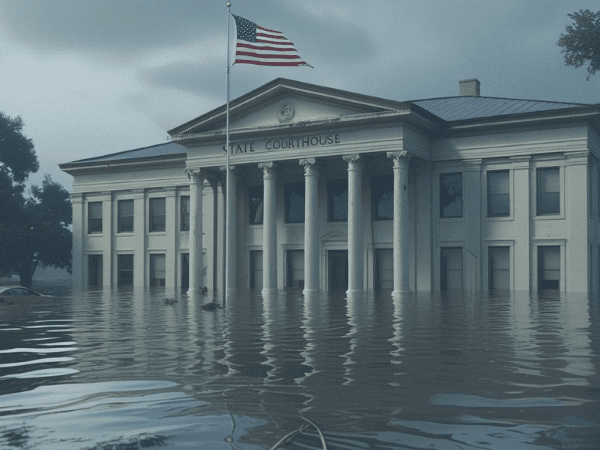World’s Biggest Court Opinion on Climate
The Drain is a weekly roundup of environmental and climate news from Legal Planet.

For more than 24 hours last week, my social media feeds were a wall of jubilant reaction to the World Court’s big climate opinion. People who work on, and care about, the climate crisis needed some good news, clearly. That begs the question, is the advisory opinion really as big a deal as people wanted to believe?
“Without a doubt. It is a huge step forward,” UCLA Law Professor Kate Mackintosh told me in an email. Mackintosh is the Executive Director of the UCLA Law Promise Institute Europe in The Netherlands where the World Court is also based.
To recap: The unanimous opinion found that nations of the world have a legal obligation to limit their emissions of greenhouse gases or else pay reparations for the harms of climate change. In its opinion, the International Court of Justice affirms the existence of a legal right to a “clean, healthy and sustainable environment” under international law and extends this and related rights to the context of climate change. Another of my UCLA Law colleagues Anna Spain Bradley explains here why the “historic” opinion could help usher in a new era of climate accountability.
By concluding that the right to a clean, healthy and sustainable environment is essential for the enjoyment of other human rights, the ICJ provides a basis for claiming it as an inherent right in future cases. It could also have big impacts on refugee law as the number of climate refugees increases.
Notably, the court also ruled that states do not have unlimited discretion when establishing their climate targets. “The targets have to be capable of meeting their contribution to keeping temperature rise to 1.5 degrees, and historic emissions have to be taken into account in devising each state’s fair share,” Mackintosh said. “As a matter of law, states must set their highest possible ambition due to the urgency of the crisis.”
Mackintosh has closely followed the case which was first filed in 2018 by Vanuatu, an archipelago in the Pacific Ocean. She organized a major 2024 conference that explored the ICJ proceedings with Prof. Margaretha Wewerinke-Singh, lead counsel for Vanuatu. Then Mackintosh was approached by the State of Palestine to assist them with their submissions in the case.
Palestine’s argument: that ICJ judges could not make a definitive pronouncement on the legal obligation of states in the face of climate change without taking into account the situation of people in armed conflict and under occupation. “This is a very important and neglected issue,” Mackintosh said.
In the case of Gaza, a 2024 report found that the immediate emissions of aerial and ground attacks during “the first 120 days of the Israel-Gaza conflict were greater than the annual emissions of 26 individual countries and territories.” When the researchers added intermediate emissions—war infrastructure built by Israel and Hamas (including the latter’s substantial tunnel network)—the total emissions increase to more than that of 36 individual countries and territories, as I wrote last June.
While this issue of conflict emissions did not appear in the unanimous joint opinion, it was taken up by the US judge, Sarah Cleveland, in her declaration, which is a separate statement of law, Mackintosh said.
“She fully validated our argument that the impacts of armed conflict (which do not currently appear in countries’ climate reports) have to be taken into account, otherwise we grossly underestimate our CO2 problem. Judge Cleveland wrote that ‘Failing to take such harms into account underreports and distorts our understanding of global warming and undermines the ability of the international community to tackle its causes.’ This is an important and emerging legal issue that the Promise Institute will continue to work on,” Mackintosh said.
Some media gave the ICJ opinion decent play. The Guardian had multiple stories, including this response from law students who helped bring the original case. NPR’s Lauren Sommers had a story on both All Things Considered in the afternoon and on Mording Edition the next day — a good indicator that NPR is going big with something. The New York Times sent out a push notification about the opinion. I especially appreciated this article from New York Times climate correspondent Somini Sengupta with immediate reaction from legal experts. NYT Opinion also published a quick reaction piece from the Center for International Environmental Law’s Nikki Reisch, Johanna Gusman, and Rebecca Brown.
 Lamentably, I saw some critics unfairly gripe on social media that the New York Times didn’t cover the news. So, it’s worth a reminder that more often than not if you hear someone say “so and so didn’t even report on this” they are going off of vibes, not facts.
Lamentably, I saw some critics unfairly gripe on social media that the New York Times didn’t cover the news. So, it’s worth a reminder that more often than not if you hear someone say “so and so didn’t even report on this” they are going off of vibes, not facts.
This big advisory opinion lands with only about 100 days until the UN climate conference taking place in Brazil and only 25 countries having submitted their climate plans, Nationally Determined Contributions, as required. “Plans from the European Union, China and India will be key,” write a pair of researchers in the Conversation.
Sure enough on Thursday, China and the European Union joined forces to pledge to work together to slow down global heating and they called the Paris Agreement “the cornerstone of international climate cooperation,” without mentioning the US.
China for its part is exporting enough solar panels, batteries and EVs that is helping to cut emissions 1% outside of China and will avoid some 4 billion tons of carbon dioxide over the lifetimes of the products, according to a new Carbon Brief analysis.
The Guardian is taking an in-depth look at China and the 9 other countries that emit the most CO2 in a series called The Big Emitters that puts a spotlight on their plans.
“The fossil fuel age is flailing and failing,” UN Chief António Guterres said in a speech last week, accusing coal, oil and gas of being “the greatest threat to energy security today.” Guterres said the “sun is rising on a clean energy age,” as 91% of new renewable power projects were cheaper than fossil fuels, according to a new IRENA report.
Dangerous Finding
While the world affirms the right to a sustainable climate, U.S. EPA is renouncing its ability to even regulate greenhouse gases as a threat to human health.
Lisa Friedman had the story early last week that a draft rule would be unveiled in coming days to eliminate the “bedrock” Endangerment Finding. NPR’s Jeff Brady reported that EPA’s proposal was under review by the White House Office of Management and Budget. Heatmap News referred to this as a “climate kill shot” which sums it up effectively. Richard Lazarus was a guest on the Living on Earth podcast talking about EPA’s new direction away from its mission and its war on the endangerment finding.
Today (Tuesday), EPA Administrator Lee Zeldin is set to announce the agency will revoke the finding that has allowed Republican and Democratic administrations to regulate climate pollution. Jean Chemnick and Zack Colman at E&E/Politico say he’ll do so at a trucking facility in Indiana.
My colleagues Ann Carlson, Mary Nichols, and Cara Horowitz have been talking with media about what this means. “Trump and Zeldin should be careful what they wish for: if the Clean Air Act can’t be used to regulate greenhouse gases, then states may be free to do so on their own without any risk of preemption,” Carlson says. Like so many of this administration’s policy rollbacks, this one looks strategic but is short-sighted. “Driving a dagger into the heart of the climate change religion,” which is weirdly what Zeldin says he’s doing, is not a way to govern.
Here’s what else to watch for this week…
Good News
Congress may save the energy-saving program Energy Star from senseless Trump cuts. Legislators in the House and Senate who are tasked with negotiating appropriations last week proposed fully funding Energy Star at $32 million for the next year. Energy Star is an energy accreditation program run by EPA that saves the US money and is popular with appliance makers.
The Science Based Targets Initiative (SBTi) launched a tougher net zero standard for banks, asset managers and insurance companies that would require these institutions to end financing for firms that are expanding coal projects immediately and for those expanding oil and gas projects by 2030, Joe Lo reports for Climate Home News.
The Occupational Safety and Health Administration has continued to move forward its first-ever draft rule to prevent heat illness in the U.S. workforce by requiring employers to provide access to water, shade, and paid breaks during heat waves. OSHA could withdraw the draft regulation, but it hasn’t, and is currently in the middle of soliciting input from the general public about the proposed policy, reports Frida Garza for Grist.
Cox Automotive predicts EV sales will hit a new record in Q3 but don’t celebrate just yet because the bump is only expected because buyers are racing to use federal incentives before they expire at the end of September, bringing a possible collapse in Q4.
Bad News
Bad news for Tesla and, schadenfreude aside, that’s bad news for the EV industry. Tesla reported a 16% decline in revenue in the second quarter, and the company’s CFO says the end of EV tax credits and looming tariffs will continue to hurt business. But the carmaker said the same day that it had begun making its long awaited “affordable model.”
Half the country — 150 million people — are under a heat dome, facing extreme or major heat risks. And that heat dome that settled over the eastern US brought record-breaking temperatures at a bad time for soccer players and fans. It made the Club World Cup tournament pretty awful, George Timms reports at Time. Severe conditions have raised concerns ahead of the 2026 World Cup hosted in the U.S., Canada, and Mexico.
A draft executive order by the Trump administration, viewed and reported on by ProPublica, directs the Secretary of Transportation to “use all available authorities to eliminate or expedite” environmental reviews for rocket launch licenses — changes that companies like Elon Musk’s SpaceX have long sought.
Businesses canceled, closed, and scaled back more than $22 billion worth of clean energy projects and new factories in the first half of 2025 after cancelling another $6.7 billion in June alone, according to E2’s latest monthly analysis.
EPA is planning to suspend Biden-era requirements for oil and gas companies to limit their methane emissions and the agency is “using a regulatory maneuver that environmental attorneys say is a backdoor bid to avoid public notice and comment” reports Jean Chemnick at E&E.
Trump issued a proclamation in July that delays a rule meant to tighten ethylene oxide emissions at companies that use the gas to sterilize medical equipment, Julia Baarajas reports for LAist. My UCLA colleague William Boyd is quoted in the piece, saying that no other president has made use of the authority Trump tapped into to issue this proclamation, which Boyd expects environmental justice advocates to challenge.
Shell is among the firms that have abandoned a years-long, high-profile attempt to define a “net zero” emissions strategy after being told that such a standard would require them to stop developing new oil and gas fields, according to the Financial Times.
California
Six in ten Californians favor the state’s goals to achieve net zero greenhouse gas emissions and 100% renewable energy by 2045. More than 80% of us favor building more solar power stations in California. These are some key findings of the Californians and the Environment survey by the Public Policy Institute of California. Another important finding that all policymakers should write down: 60% say they are very concerned that home insurance will become more expensive, and 57 % say that Californians will be unable to obtain home insurance due to climate-change risks.
Michael Wara at Stanford has some good advice for PPIC pollsters, because we already know people are willing to pay more for their electricity if it is clean. “The better question here I think would have been whether people are willing to pay more for their gasoline in order to pay for infrastructure to support EVs,” Wara wrote on Bluesky. “That is the real issue and challenge. Renewables aren’t more expensive.”
A California agency called the Office of Environmental Health Hazard Assessment could take on an even bigger role now that EPA has killed off its research arm, LAT’s Hayley Smith reports. California Secretary for Environmental Protection Yana Garcia told Smith that California has hired a number of people from the federal government over the past year and is open to absorbing more EPA employees who were laid off.
I wrote earlier in July about the Trump administration’s fairly crazy proposals for opening public lands to a lot more oil and gas leases. If you thought Gov. Newsom would lead the fight, you’d be wrong. ”Instead of fighting back, Newsom followed up last week with his own proposal to streamline permitting for oil and gas drilling at existing wells and exempt fossil fuel operations from environmental review,” wrote Ryan Schleeter for the Climate Center. My Legal Planet colleague Ken Alex shares some thoughts on what California should get out of such a proposal.
State lawmakers are under pressure from Big Ag to kill or change legislation that would make it easier to convert farmland to solar production, Sammy Roth reports for Boiling Point. AB 1156 would “boost solar by weakening a law called the Williamson Act, which is designed to keep lands in crop production. AB 1156 would let growers in water-stressed areas suspend their contracts to enable solar development, without anyone paying the fee.”
And oh boy. For the last several months, CAISO has been piloting a generative AI platform that it hopes will streamline the process of managing outages “and help it meet the compounding demands of outage coordination,” reports Maeve Allsup at Latitude Media.
California government officials are trying to find a buyer for Valero Energy’s Benicia refinery near San Francisco before it closes next April, which Reuters reports is an unusual effort “by a state government to broker the sale of privately-owned infrastructure” and” reflects its growing concerns over protecting fuel supplies in the most populous U.S. state and keeping a lid on prices.”
The State Water Resources Control Board sided with Gov. Newsom and other big commercial stakeholders in the state’s water supply interested in providing water from the Sacramento-San Joaquin Delta and connecting rivers into big Southern California cities and Central Valley agriculture regardless of concerns brought about by “conservationists, the fishing industry, Delta communities, and Native tribes” reports Rachel Becker for CalMatters.
The Trump’s administration’s plans to suspend the “roadless rule” could threaten more than 4 million acres of forests in California, Becker also reports in a PBS video.
“Freebates” are one of the proposals under consideration by CARB as they confront the loss of federal EV rebates and Clean Air waivers, Michael Stoll for SF Public Press reports, calling freebates “economically elegant but politically unproven.”
FEMA, Disasters, and Extreme Weather

A ProPublica and Texas Tribune analysis of legislative proposals finds that the Legislature has repeatedly failed to enact key measures that would help communities prepare for frequent flooding, as recently as this legislative session.
The science of a heat dome is terrifying and poetic (a “self-reinforcing machine of misery”), as described by Matt Simon for Grist. Why we call it a “heat dome” got this explainer from Jeva Lange at Heatmap News.
Researchers at the UCLA Fielding School of Public Health announced last week they had finished installing 20 air quality sensors to measure pollution, stretching from the Palisades Highlands to Santa Monica.
Edison unveiled a Wildfire Recovery Compensation Program that could be used to quickly pay Eaton fire victims, including those who were insured, but there’s concern that it’s also a plot to have Altadena residents waive some rights to avoid costly litigation, reports Melody Peterson for LAT.
COP30, Brazil and Forests
Forest carbon sink has hit a record low for at least the last 2 decades: New analysis of data from WRI’s Global Forest Watch and Land & Carbon Lab reveals that extreme fires caused forests to absorb far less carbon than usual in 2023 and 2024, about one quarter of what is typical, weakening their cooling effect.
The New York Times ran a Sunday front page report on the upcoming COP30 conference but they went with the salacious framing of “Dance poles and leopard-print walls” as a way to convey the scarcity of rooms in Belem and the rush to find more lodging ahead of COP30, including “love motels.”
Meanwhile Climate Home News reports that the online platform for approved accommodation is now “operational” and that 98 of the “smallest developing countries and island nations” will get first dibs on 3,900 rooms on two cruise ships docked a 30-minute drive away from the COP30 venue for a maximum of $220 a night.
Energy

In Australia, taxpayers face a potential $500 million bill to clean up aging oil and gas infrastructure left by Chevron off Western Australia’s Pilbara, according to reporting by Boiling Cold.
Trump signed an AI executive order designed to speed permitting for data centers and related power generation on federal land. The order ignores wind and solar while promoting fossil fuel, advanced nuclear, and geothermal as power options. He promised the US would build as much new electricity capacity as China this year, E&E reports.
And all climate tech companies are now data center companies now because that’s where the money is, Katie Brigham writes for Heatmap News. “The proportion of pitches that we see that reflects some kind of data center messaging has gone from maybe one out of 20 to one out of five,” one venture capital source said.
Despite the Trump administration’s knee-jerk cancellation of a $4.9 billion federal loan guarantee for the Grain Belt Express transmission project, developer Invenergy indicates the plan would move forward for the massive project with private financing, AP reports.
The rates are too damned high and Democrats will need a strategic plan to stabilize or cut electricity costs heading into 2028, Robinson Meyer writes at Heatmap news. “They will need ideas about how (and whether) to speed up permitting, restructure wholesale power markets, and build new power plants in order to stabilize the power grid.” We need it like yesterday.
Media Stories
Grist profiles Reverb, a nonprofit that’s become a leading force in greening live music. Its staffers are on the road this summer with Dave Matthews Band and Billie Eilish, setting up eco-villages and organizing volunteers. These Reverb staffers serve as the bands’ de facto sustainability coordinators, allowing initiatives like RockNRefill to be scaled up, rather than every artist having to go it alone.
If you haven’t yet explored the 50 States, 50 Fixes series from the New York Times’ Climate desk, go check it out now. Cara Buckley and Catrin Einhorn are reporting on grassroots problems and solutions with help from readers. Like in New Mexico, where this Indigenous-led nonprofit group is bringing solar power to Navajo Nation and the Hopi tribe. They have reached the midway point: 25 states down, 25 to go.
Alexander C. Kaufman is now writing the Heatmap AM Briefing newsletter, which puts 5 big climate and weather stories in your inbox daily for free. Kaufman, an award-winning journalist, has covered energy and climate for lots of places and has already put an emphasis on energy companies.







Reader Comments